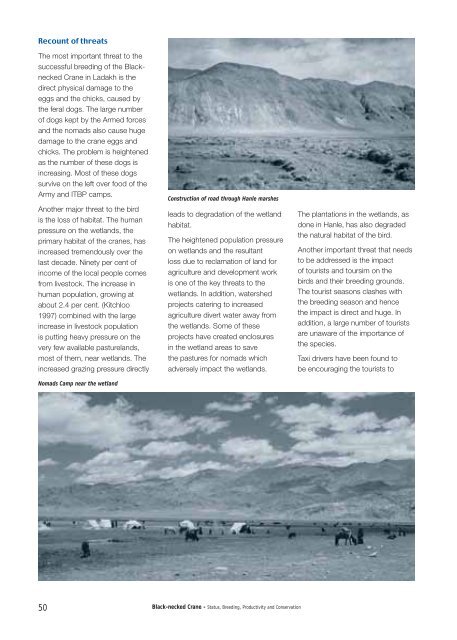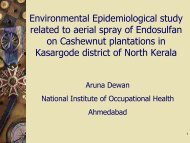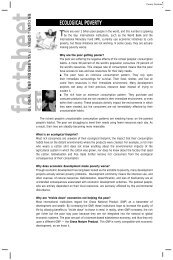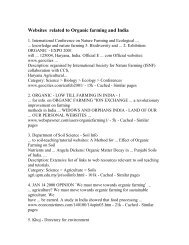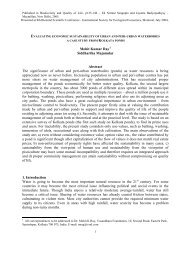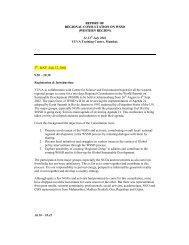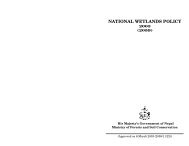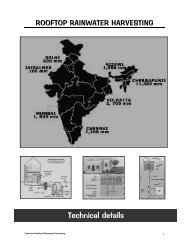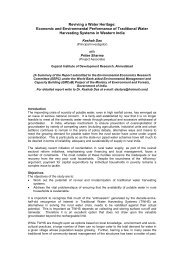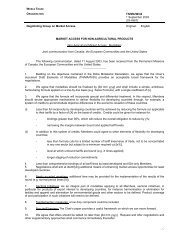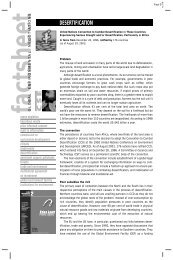Black-necked Crane - WWF-India
Black-necked Crane - WWF-India
Black-necked Crane - WWF-India
Create successful ePaper yourself
Turn your PDF publications into a flip-book with our unique Google optimized e-Paper software.
Recount of threats<br />
The most important threat to the<br />
successful breeding of the <strong>Black</strong><strong>necked</strong><br />
<strong>Crane</strong> in Ladakh is the<br />
direct physical damage to the<br />
eggs and the chicks, caused by<br />
the feral dogs. The large number<br />
of dogs kept by the Armed forces<br />
and the nomads also cause huge<br />
damage to the crane eggs and<br />
chicks. The problem is heightened<br />
as the number of these dogs is<br />
increasing. Most of these dogs<br />
survive on the left over food of the<br />
Army and ITBP camps.<br />
Another major threat to the bird<br />
is the loss of habitat. The human<br />
pressure on the wetlands, the<br />
primary habitat of the cranes, has<br />
increased tremendously over the<br />
last decade. Ninety per cent of<br />
income of the local people comes<br />
from livestock. The increase in<br />
human population, growing at<br />
about 2.4 per cent. (Kitchloo<br />
1997) combined with the large<br />
increase in livestock population<br />
is putting heavy pressure on the<br />
very few available pasturelands,<br />
most of them, near wetlands. The<br />
increased grazing pressure directly<br />
Nomads Camp near the wetland<br />
Construction of road through Hanle marshes<br />
leads to degradation of the wetland<br />
habitat.<br />
The heightened population pressure<br />
on wetlands and the resultant<br />
loss due to reclamation of land for<br />
agriculture and development work<br />
is one of the key threats to the<br />
wetlands. In addition, watershed<br />
projects catering to increased<br />
agriculture divert water away from<br />
the wetlands. Some of these<br />
projects have created enclosures<br />
in the wetland areas to save<br />
the pastures for nomads which<br />
adversely impact the wetlands.<br />
The plantations in the wetlands, as<br />
done in Hanle, has also degraded<br />
the natural habitat of the bird.<br />
Another important threat that needs<br />
to be addressed is the impact<br />
of tourists and toursim on the<br />
birds and their breeding grounds.<br />
The tourist seasons clashes with<br />
the breeding season and hence<br />
the impact is direct and huge. In<br />
addition, a large number of tourists<br />
are unaware of the importance of<br />
the species.<br />
Taxi drivers have been found to<br />
be encouraging the tourists to<br />
50<br />
<strong>Black</strong>-<strong>necked</strong> <strong>Crane</strong> - Status, Breeding, Productivity and Conservation


